英语段落写作方法与技巧
英语段落写作方法精选

英语段落写作方法精选英语写作被广泛地运用于生活的各个领域,良好的英语写作能力是进行有效交流所必备的元素。
下面是店铺带来的英语段落写作法,欢迎阅读!英语段落写作法精选一、如何写好段落的主题句主题句是对段落中心思想的概括,具有统率全段的作用,它可以位于段落的开头、中间或结尾。
但通常应位于段落的开头。
写主题句时应该注意以下几点:1确定主题的方向和范围。
一个段落只能有一个主题。
例如:“the advantages of watching television”这个主题就完全可以用一段文字来叙述。
但如果题目扩展为:“the ad-vantages and disadvantages of watching television”,那么就需要用两段文字分别加以论述。
因为其中含有两个主题,即“advantages”和“disadvantages”。
段落主题的大小一定要适当,比如“solar energy”这个主题对一段文字来说过大,单个段落根本无法说明清楚。
若将其缩小为“the solar water heater installed at building 39”就更适合段落主题了。
缩小主题范围的方法很多,其中一种就是挑选涉及范围较广的主题的某个具体方面,或用时间、地点对其加以限制。
如:主题过大→较大→具体public transportation→the subway system→the subway line in Beijinggardening→vegetable gardening→growing carrotsanimals→dogs→the dog I bought yesterday2主题必须是段落内容的浓缩,它必须具备展开,即进一步说明的可能。
如果过于具体,则很难对之加以论述。
如:“The Sony word processor costs 40.”就过于具体。
若改成“The Sony word processor is an efficient machine.” 就比较好。
英文写作技巧如何撰写清晰的主题句

英文写作技巧如何撰写清晰的主题句如何撰写清晰的主题句英语写作中,一个好的主题句可以为整个段落或文章提供骨架,有助于读者理解你的观点和逻辑。
撰写一个清晰的主题句是确保你的写作连贯性和思路清晰的关键。
下面将探讨几种方法,帮助你提高英文写作的技巧,撰写出更清晰的主题句。
1. 强调句子结构一个清晰的主题句应该直接概括你将要讨论的主要观点。
使用强调句子结构可以让主题句更加明确和突出。
可以考虑使用倒装句结构、强调副词或独立主格等方法。
例如,"Not only does regular exercise improve physical health, but it can also have a positive impact on mental well-being"(不仅常规锻炼有助于改善身体健康,还可以对心理健康产生积极影响)。
2. 使用具体明确的词语和短语清晰的主题句应该具备明确、具体的表达方式。
避免使用模糊不清的概念或词语,例如"good"或"bad"。
相反,选择具体的词语和短语,准确传达你的观点。
例如,"The use of technology in classrooms enhances students' learning experience and promotes engagement"(在教室中运用技术能够提高学生的学习体验,并促进学生参与)。
3. 遵循逻辑顺序一个清晰的主题句应该与整个段落或文章的逻辑顺序相一致。
确保主题句在语义上和结构上与前后句子有着合理的连贯性。
可以使用过渡词或短语,如"however"、"therefore"、"on the other hand"等,有助于引导读者理解你的论点。
例如,"Although technology has revolutionized communication, face-to-face interaction still plays a vital role in fostering strong relationships."4. 突出关键观点清晰的主题句应该突出表达你的关键观点,帮助读者迅速理解你的写作目的。
英语段落写作方法技巧指导
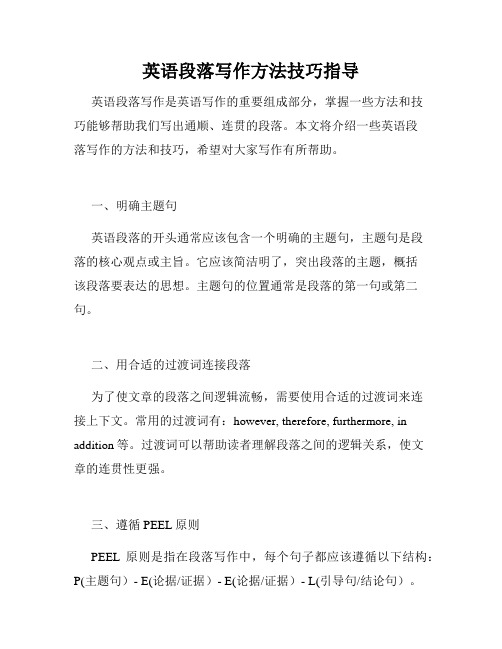
英语段落写作方法技巧指导英语段落写作是英语写作的重要组成部分,掌握一些方法和技巧能够帮助我们写出通顺、连贯的段落。
本文将介绍一些英语段落写作的方法和技巧,希望对大家写作有所帮助。
一、明确主题句英语段落的开头通常应该包含一个明确的主题句,主题句是段落的核心观点或主旨。
它应该简洁明了,突出段落的主题,概括该段落要表达的思想。
主题句的位置通常是段落的第一句或第二句。
二、用合适的过渡词连接段落为了使文章的段落之间逻辑流畅,需要使用合适的过渡词来连接上下文。
常用的过渡词有:however, therefore, furthermore, in addition等。
过渡词可以帮助读者理解段落之间的逻辑关系,使文章的连贯性更强。
三、遵循PEEL原则PEEL原则是指在段落写作中,每个句子都应该遵循以下结构:P(主题句)- E(论据/证据)- E(论据/证据)- L(引导句/结论句)。
主题句概括了段落的主旨,论据/证据支持主题句,引导句/结论句总结段落内容。
四、使用恰当的标点符号正确使用标点符号可以使文章更加清晰和易读。
常见的标点符号包括句号、逗号、问号、感叹号等。
正确的标点使用能够帮助读者在阅读过程中把握句子的节奏和表达方式。
五、注意段落长度段落的长度最好控制在3-5句话之间。
段落过长容易使文章显得累赘,段落过短又显得零碎。
合理的段落长度有助于保持文章的连贯性和结构的有序性。
六、注重段落结构在写作段落时,可以根据需要使用不同的结构。
例如,常用的结构有时间顺序、因果关系、问题解决等。
通过合理运用不同的结构可以使段落表达更加丰富,增强文章的逻辑性和说服力。
七、使用举例和引用为了支持段落的论点,可以使用举例和引用。
举例可以通过具体例子来解释观点,使文章更具说服力;引用可以引述权威人士的言论或观点,为段落提供权威性。
总结:英语段落写作是提高英语写作水平的重要环节。
通过明确主题句、运用合适的过渡词、遵循PEEL原则、使用恰当的标点符号、控制段落长度、注重段落结构以及使用举例和引用等方法和技巧,我们可以写出通顺、连贯的英语段落。
英语作文段落写作的有效方法-英语写作技巧

1.比较与对照的基本定义比较(comparison)主要是指出两个或两个以上不同种类的共同点或相似点(similarities),如人物、事物、地点、思想、观点等。
对照(contrast)主要是指它们的不同点(difference)。
在大学英语中,比较和对照法往往同时使用。
写作时,首先应考虑要比较和对照的两个或两个以上的事物,然后列一个表,发现这些事物的最主要特征,相同的或类似的特征可以比较,不同的特征可以组成对照。
例如:例 1.Punctuality is the main constituent of good character.Aperson,who is always in time for his appointment,shows real considerationfor others.On the other hand,a person who is always lateshows his selfishness and thoughtlessness and he is not worthy tobe friend with.(本段对守时(in time)与不能守时(late)的两种不同的人进行了对照,用表示对照的连接词“On the otherhand”进行了很好的连接。
)。
例 2.Paintings and photographs have something in common.But there are also some differences between them.(这段很好地展示出本文将用比较与对照的方法进行写作。
)Paintings and photographs are visual art forms.They both cancapture a specific moment for all time.A painting reflects the skilland talent of a painter,likewise the quality of a photograph canrepresent the skill and talent of a photographer.(本段对paintingsand photographs两个不同的种类进行了分析,用连接词(both)进行了很好的连接,用连接词(likewise)用同样的方式对它们的相同点(the skill and talent)进行了比较)。
英语段落写作技巧学习

英语段落写作技巧学习段落是构成篇章的基础,学习英文篇章必须从段落写作开始。
下面是店铺带来的英语段落写作技巧,欢迎阅读!英语段落写作技巧精选主题句与推展句1. 主题句主题句(topic sentence)是表达段落主题的句子。
它用以概括段落大意,要求全段其他文字都围绕它展开。
请看下例:My mother has passed along to me certain rules for getting along with others. Don't argue with parents; they will think you don't love them. Don't argue with children; they will think themselves victimized. Don't argue with spouses; they will think you are a tiresome mate. Don't argue with strangers; they will think you are not friendly. My mother's rules, in fact, can be summed up in two words: Don't argue.主题句中提出的"certain rules" 指的是什么?展开句中通过四个"Don't argue --" 逐一加以交代。
从结构来看,这是一个比较典型的段落,它包括了主题句,推展句和结论句(即本段中的末句)。
1.1 主题句的位置主题句通常放在段落的开端,其特点是开门见山地摆出问题,然后加以详细说明。
其作用是使文章的结构更清晰,更具说服力,便于读者迅速地把握主题和想象全段的内容。
主题句可以放在段中起到承上启下的作用,或放在段尾起概括全段的作用。
英语段落写作方法与技巧

英语段落写作方法与技巧英语段落写作方法与技巧主题句对于段落的重要性是毋庸质疑的,因此,主题句的优劣将直接关系到该段落的写作质量。
好的主题句不仅能够起到限定段落基调的作用,而且起到限定主题范围的作用。
主题句明确地限定了段落内容,这样,习作者在、筛选与主题相关的事实、例证、节时才能够较容易地把握住方向。
而且,主题突出的主题句也能使读者一日了然,有利于读者预测下文内容。
倘假设段落的主题句过于笼统或模糊,就无法成为整个段落开展的指南针,就难以合理组织相关材料来进一步摇述、说孵或阐述主题,甚至使整个段落乃至整篇文章构造松散、逻辑不清。
尽管主题句十分重要,但它不能没有扩展句的支持。
扩展句就是对主题句所陈述的思想观点加以展开分类,提出各种细节或例证以阐述或证明主题的各个方面。
扩展句就像是段落的血肉,“有血有肉”的段落才能感染读者、说服读者,才能到达写作的根本目的。
在主题句确定后,习作者就要开始选择和主题有关的信息和素材。
实质上,针对主题测试每~个所选择素材就是一个分类过程。
有一种常用方法就是句子展开前加以设问,然后解答,即设问一解答(why-because)方法。
写作者在写作中要做到连贯性,就必须注意句子与句子之间的衔接(cohesion)。
文章通过一定的衔接手段,将句与句,段与段有机地组合起来,构成一个完整的语义单位。
实现段落连贯的过渡手段主要是词汇或语法手段和逻辑顺序。
对于习作者来说,掌握必要的衔接技巧是十分重要的。
综上所述,在英语写作中,一个段落应该具有三大组成部分和两大要素,即包含主题句、扩展句、结论句和具有一致性、连贯性。
了保证段落中心突出,构造完整,表达连贯,习作者必须掌握必要的衔接技巧。
英语写作中的段落组织技巧

英语写作中的段落组织技巧段落是英语写作中的重要组成部分,良好的段落组织可以使文章结构清晰、逻辑严密,提升文章的可读性和说服力。
本文将介绍几种在英语写作中常用的段落组织技巧。
一、主题句主题句是一个段落的核心句子,它概括或者总结了该段落的主要内容。
主题句通常在段落的开头或者结尾出现,帮助读者快速理解段落的主旨。
通过使用主题句,写作者可以有效地组织段落的内容,使文章更具连贯性。
例如,在写一篇关于旅游的文章中,如果某段主要介绍海滩的风景,可以使用如下的主题句:“The beach is a picturesque destination with beautiful white sand and crystal clear waters.”(海滩是一个风景如画的地方,拥有美丽的白色沙滩和清澈的水域。
)二、层次结构在段落组织时,可以利用层次结构的方式将相关的信息放置在一起。
先将最重要的点放在开头,紧接着是次要点,最后是具体例子或者解释。
这种层次结构能够使段落更富有逻辑性和组织性。
例如,如果我们写一篇关于环保的文章,想要探讨减少塑料污染的方法。
可以先提出主要观点:“To reduce p lastic pollution, it is important to reduce the use of single-use plastic products.”接着可以讨论次要观点:“One way to achieve this is by promoting the use of reusable bags and water bottles.”最后可以通过具体的例子对此进行解释:“For instance, bringing our own bags to the grocery store and using refillable water bottles instead of disposable ones can make a significant difference in reducing plastic waste.”三、顺序与对比在英语写作中,使用顺序与对比的手法可以使段落更具逻辑性。
英文写作中的段落结构与过渡技巧

英文写作中的段落结构与过渡技巧在英语写作中,良好的段落结构和流畅的过渡是写作的关键。
一个段落应该有明确的主题,并且从一个思想到另一个思想之间应该有清晰的连接。
以下是一些在英文写作中使用的段落结构和过渡技巧。
1. 开篇引出主题一个好的段落应该以一个明确的主题句开始,这句话应该简洁明了地概括出该段落要讨论的主题。
例如,如果你想写一篇关于科技对现代社会的影响的文章,你可以在第一个段落中写:“科技在现代社会中扮演着至关重要的角色。
” 这句话将引出整个段落的主题。
2. 提供支持性论据接下来的几个句子应该提供支持性的论据来支持你的主题句。
你可以用现实生活中的例子、调查数据或其他可信来源的信息来证明你的观点。
例如,如果你正在讨论科技对教育的影响,你可以提供一些研究结果,表明使用科技设备在课堂上能够提高学生的学习成绩。
3. 引出下一个论点在段落的结尾,你应该引出下一个要讨论的论点。
这可以通过一些类似于“此外”、“另外”、“除此之外”之类的过渡词来实现。
这个过渡句将帮助你平稳地过渡到下一个段落。
例如,在讨论科技对社交关系的影响之后,你可以写:“除了对教育的影响,科技也在社交关系中扮演着重要的角色。
”4. 过渡词的使用过渡词在段落之间的过渡中起着重要的作用。
它们帮助连接一个段落的思想到下一个段落的思想,使整篇文章更具连贯性。
例如,当你结束一个段落时,你可以使用过渡词“同时”或“然而”来引出下一个段落的思想。
5. 反思和总结段落的结尾非常重要,它应该反思和总结整个段落的内容,并为下一个段落提供一个引子。
这将使读者更容易理解你的观点并跟上你的思路。
例如,在讨论科技对社交关系的影响之后,你可以写:“因此,虽然科技在许多方面为我们带来了便利,但它也对我们的社交关系产生了消极的影响。
”在英文写作中,正确地构建段落结构和使用适当的过渡词对于传达你的思想和保持读者的兴趣非常重要。
通过遵循以上提到的几个技巧,你将能够写出更好的英文段落,使你的写作更加流畅和有条理。
英语写作中的段落结构

英语写作中的段落结构在英语写作中,段落结构是非常重要的,它决定了文章的逻辑连贯性和条理性。
一个好的段落结构可以使文章更易读、更有说服力。
本文将探讨英语写作中的段落结构,包括段落的组成部分、段落的功能以及一些有效的段落写作技巧。
一、段落的组成部分一个完整的段落通常由三个部分组成:主题句、支持句和结论句。
主题句是段落的核心,它概括了整个段落的主题和观点。
主题句通常出现在段落的开头,可以帮助读者快速了解段落的内容。
一个好的主题句应该简明扼要地表达段落的中心思想。
支持句是段落的主体部分,用来支持和解释主题句。
支持句可以通过提供具体的例子、引用权威的观点或者进行逻辑推理来支持主题句。
支持句的数量和顺序应该根据段落的需要进行调整,以确保段落的逻辑连贯性和条理性。
结论句是段落的总结部分,用来总结段落的主要观点或者提出进一步的思考。
结论句可以通过回顾主题句和支持句的内容来得出一个结论,也可以提出一个问题或者展望未来的研究方向。
二、段落的功能段落的主要功能是将文章的内容组织成一系列有条理的思想和观点。
通过合理的段落结构,读者可以更容易地理解和记忆文章的内容。
此外,段落还可以帮助作者表达自己的观点和论证,使文章更有说服力。
段落可以起到承上启下的作用,将前后段之间的思想联系起来。
一个好的段落应该能够与前后段之间建立起逻辑关系,使整篇文章的思路连贯一致。
段落还可以用来展开和发展一个主题或者观点。
通过提供具体的例子、引用权威的观点或者进行逻辑推理,段落可以帮助读者更深入地理解和思考一个主题或者观点。
三、段落写作技巧在写作段落时,有一些技巧可以帮助我们更好地组织和表达思想。
首先,要确保每个段落都有一个清晰的主题句。
主题句应该概括整个段落的中心思想,避免过于笼统或者模糊不清。
其次,要注意段落之间的过渡。
段落之间的过渡应该自然流畅,使读者能够顺利地跟随思路。
可以使用一些过渡词或者短语来引导读者,如"另一方面"、"相比之下"等。
专四英语写作技巧
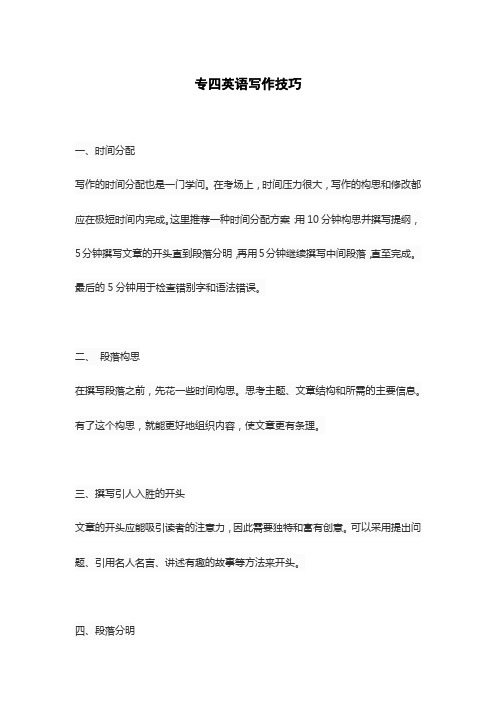
专四英语写作技巧
一、时间分配
写作的时间分配也是一门学问。
在考场上,时间压力很大,写作的构思和修改都应在极短时间内完成。
这里推荐一种时间分配方案:用10分钟构思并撰写提纲,5分钟撰写文章的开头直到段落分明,再用5分钟继续撰写中间段落,直至完成。
最后的5分钟用于检查错别字和语法错误。
二、段落构思
在撰写段落之前,先花一些时间构思。
思考主题、文章结构和所需的主要信息。
有了这个构思,就能更好地组织内容,使文章更有条理。
三、撰写引人入胜的开头
文章的开头应能吸引读者的注意力,因此需要独特和富有创意。
可以采用提出问题、引用名人名言、讲述有趣的故事等方法来开头。
四、段落分明
文章应分为三段:开头、主体和结尾。
主体部分应包含两个或更多的段落,每个段落应有一个明确的主题。
五、语法和拼写检查
完成文章后,务必进行语法和拼写检查。
这不仅能纠正错误,还能提高文章的整体质量。
六、结尾总结
结尾部分应总结全文,再次强调主要观点,给读者留下深刻印象。
七、练习写作
提高写作技巧的关键是练习。
可以定期写一些小作文,并请老师或朋友进行批改。
多读英文原著也有助于提高写作能力。
通过遵循这些技巧,你的专四英语写作能力一定会有所提高。
记住,不断练习是提高写作能力的关键。
初中英语作文写作技巧大全+万能作文模板

初中英语作文写作技巧大全+万能作文模板英语作文一直是初中同学的老大难问题,很多同学都得不了高分。
今天给同学们整理了初中英语作文技巧和万能模板,同学们平时多做训练,这样一定能在英语考试时作文直冲满分。
一、掌握技巧(1)注意篇章结构,合理布局开始部分(opening paragraph)说出文中的要点、核心问题。
正文部分(body paragraph)围绕主题展开叙述、讨论。
结尾部分(concluding paragraph)对全文内容进行总结和概括。
作文整体要做到全文中心突出、段落之间必须是有机地联系,内容完整、连贯,前后呼应,去除与主题无关的内容。
(2)确定主题句主题句是全文对概括,是文章的主旨。
它能在文章中起到“画龙点睛”的作用。
通常主旨句最好放在作文的开头,而后是对全文主题句所提出的内容进行解释、论述。
写主题句应该注意一下几点:归纳出文章的几个要点;提炼出一句具有概括性的话;题句赢具有可持续性,抓住、吸引读者。
重要连接词要想使文章有整体性、连贯性,就要学会正确使用连接词表示顺序增加First, second, third,First, then / ne某t, after that / ne某t, finally For one thing … for another…,On (the) one hand…on the other hand,Besides / what’s more / in addition / furthermore / moreover / another / also,Especially / In particular,表示时间顺序now, at present, recently,after, afterwards, after that, after a while, in a few days,at first, in the beginning, to begin with,later, ne某t, finally,immediately, soon, suddenly, all of a sudden, at that moment, as soon as, the momentform now on, from then on,at the same time, meanwhile,till, not…until, before, after, when, while, as du ring,表示解释说明now, in addition, for e某ample, for instance, in this case, moreoverfurthermore, in fact, actually表示转折关系but, however, while, though, or, otherwise, on the contrary, on the otherhand, in contrast, despite, in spite of, even though, e某cept (for), instead, ofcourse, after all,表示并列关系or, and, also, too, not only … but also, as well as, both… and, either …or, neither…nor表示因果关系because, because of, since, now that, as, thanks to…, due to…, therefore, as aresult (of), otherwise, so…that, such…that表示条件关系as (so) long as, on condition that, if, unless表示让步关系though, although, as, even if, even though, whether …or…, however, whoever,whatever, whichever, wherever, whenever, no matter how (who, what, which, where, when,whom)表示举例for e某ample, for instance, such as…, take… for e某ample 表示比较be similar to, similarly, the same as, in contrast, compared with (to)…just like,just as,表示目的for this reason,, for this purpose, so that, in order to, so as to,表示强调in deed, in fact, surely, certainly, no doubt, without any doubt, truly,obviously, above all,表示概括归纳in a word, in short, in brief, on the whole, generally speaking, in my opinion, as far as I know, As we all know, as has been stated, as I have shown, finally, at last, in summary, in conclusion,二、经典模板阐述主题题型要求从一句话或一个主题出发,按照提纲的要求进行论述.1. 阐述名言或主题所蕴涵的意义.2. 分析并举例使其更充实.二、中考英语作文万能模板:解决方法题型要求考生列举出解决问题的多种途径1. 问题现状2. 怎样解决(解决方案的优缺点)In recent days, we have to face a problem-----A, which is becoming more and more serious. First, -----(说明A的现状).Second, ----------(举例进一步说明现状)Confronted with A, we should take a series of effective measures to cope with the situation. For one thing, ----------(解决方法一). For another ---------(解决方法二). Finally, ---------(解决方法三). Personally, I believe that --------(我的解决方法). Consequently, I’m confident that a bright future is awaiti ng us because ----------(带来的好处).说明利弊题型这种题型往往要求先说明一下现状,再对比事物本身的利弊,有时也会单从一个角度(利或弊)出发,最后往往要求考生表明自己的态度(或对事物前景提出预测)1. 说明事物现状2. 事物本身的优缺点(或一方面)3. 你对现状(或前景)的看法Nowadays many people prefer A because it has a significant role in our daily life. Generally, its advantages can be seen as follows. First ----------------(A的优点之一). Besides -------------------(A的优点之二).But every coin has two sides. The negative aspects are also apparent. One of the important disadvantages is that ----------------(A的第一个缺点).To make matters worse,------------------(A的第二个缺点).Through the above analysis, I believe that the positive aspects overweigh the negative ones. Therefore, I would like to ---------------(我的看法).(From the comparison between these positive and negative effects of A, we should take it reasonably and do it according to the circumstances we are in. Only by this way, ---------------(对前景的预测).)议论文的框架(1) 不同观点列举型( 选择型 )There is a widespread concern over the issue that __作文题目_____. But it is well known that the opinion concerning this hottopic varies from person to person. A majority of people think that _ 观点一________. In their views there are 2 factors contributing to this attitude as follows: in the first place, ___原因一_______.Furthermore, in the second place, ___原因二_____. So it goes without saying that ___观点一_____.People, however, differ in their opinions on this matter. Some people hold the idea that ___观点二_______. In their point of view, on the one hand, ___原因一_______. On the other hand, ____原因二_____. Therefore, there is no doubt that ___观点二______.As far as I am concerned, I firmly support the view that __观点一或二______. It is not only because ________, but also because_________. The more _______, the more ________.(2)利弊型的议论文Nowadays, there is a widespread concern over (the issue that)___作文题目______. In fact, there are both advantages and disadvantagesin __题目议题_____. Generally speaking, it is widely believed there are several positive aspects as follows. Firstly, ___优点一______. And secondly ___优点二_____.Just As a popular saying goes, "every coin has two sides", __讨论议题______ is no e某ception, and in another word, it still has negative aspects. To begin with, ___缺点一______. In addition, ____缺点二______.To sum up, we should try to bring the advantages of __讨论议题____ into full play, and reduce the disadvantages to the minimum at the same time. In that case, we will definitely make a better use of the ____讨论议题___.图表作文的框架as is shown/indicated/illustrated by the figure/percentage in the table(graph/picture/pie/chart), ___作文题目的议题_____ has been on rise/ decrease (goesup/increases/drops/decreases),significantly/dramatically/steadily rising/decreasing from ______in _______ to ______ in _____. From the sharp/marked decline/ rise in the chart, it goes without saying that ________.There are at least two good reasons accounting for ______. On the one hand, ________. On the other hand, _______ is due to thefact that ________. In addition, ________ is responsible for _______. Maybe there are some other reasons to show________.But it is generally believed that the above mentioned reasons are commonly convincing.As far as I am concerned,I hold the point of view that _______. I am sure my opinion is both sound and well-grounded.现象说明文(新中国成立以来发生了翻天覆地的变化,)Recently _______,what amazes us most is______________,it is ture that__________.There are many reasons e某plaining__________________________. The main reason is___________________.what ismore_________________________.thirdly______________________.As a result_______________.Considering all there,_____________________.For onething_________________,for another_____________ . InConclusion____________________.一种事物或现象(负面意义倾向)关于A的话题,早已引起了广泛的社会关注。
英语段落内容写作方法

英语段落内容写作方法英语作文是学习英语的一项重要任务,掌握有效的写作方法可以帮助我们提高写作水平。
本文将介绍几种常用的英语段落内容写作方法,帮助读者更好地组织和表达思想。
一、结构清晰一个好的段落应该具有结构清晰的特点。
可采用以下结构:主题句-支持细节-总结句。
主题句概括了整个段落的主要思想,支持细节用来证明或解释主题句,而总结句则对整个段落进行总结。
例如,我们来看一个关于环保的段落:主题句:Protecting the environment is crucial for our future.支持细节:Firstly, pollution is causing great harm to our planet. Secondly, deforestation is leading to the loss of biodiversity. Thirdly, excessive use of fossil fuels is contributing to global warming.总结句:In conclusion, taking action to protect the environment is not only necessary but also our responsibility.在写作过程中,我们可以根据需要增加或减少支持细节,使段落的内容更具说服力和连贯性。
二、使用连接词使用连接词可以使段落更具逻辑性和连贯性。
连接词可以在句子之间或段落之间起到过渡的作用,使得整个文章更加流畅。
以下是一些常用的连接词和短语:- 表示添加:in addition, furthermore, moreover- 表示对比:on the other hand, however, nevertheless- 表示因果关系:therefore, thus, consequently- 表示总结:in conclusion, to sum up, in summary例句:Moreover, excessive use of plastic bags is also damaging to marine life. Therefore, it is important for us to reduce our consumption of single-use plastic products.三、适当使用衔接词衔接词可以将不同段落之间的主题联系起来,使文章更具连贯性。
高一英语写作中段落设置有哪些技巧
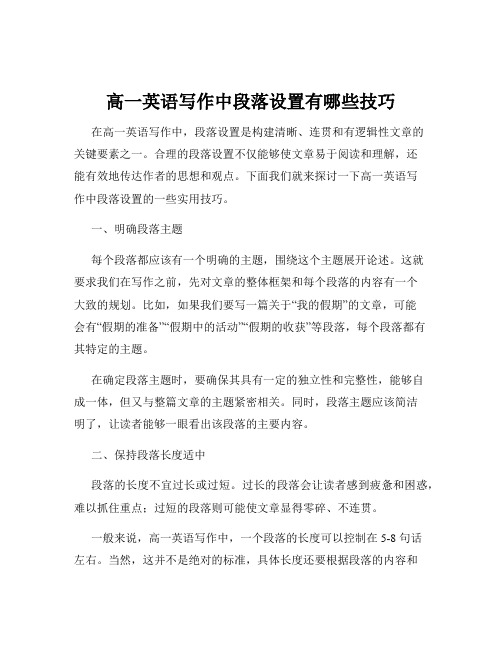
高一英语写作中段落设置有哪些技巧在高一英语写作中,段落设置是构建清晰、连贯和有逻辑性文章的关键要素之一。
合理的段落设置不仅能够使文章易于阅读和理解,还能有效地传达作者的思想和观点。
下面我们就来探讨一下高一英语写作中段落设置的一些实用技巧。
一、明确段落主题每个段落都应该有一个明确的主题,围绕这个主题展开论述。
这就要求我们在写作之前,先对文章的整体框架和每个段落的内容有一个大致的规划。
比如,如果我们要写一篇关于“我的假期”的文章,可能会有“假期的准备”“假期中的活动”“假期的收获”等段落,每个段落都有其特定的主题。
在确定段落主题时,要确保其具有一定的独立性和完整性,能够自成一体,但又与整篇文章的主题紧密相关。
同时,段落主题应该简洁明了,让读者能够一眼看出该段落的主要内容。
二、保持段落长度适中段落的长度不宜过长或过短。
过长的段落会让读者感到疲惫和困惑,难以抓住重点;过短的段落则可能使文章显得零碎、不连贯。
一般来说,高一英语写作中,一个段落的长度可以控制在 5-8 句话左右。
当然,这并不是绝对的标准,具体长度还要根据段落的内容和表达的需要来决定。
如果一个观点需要详细阐述,可以适当增加段落的长度;如果只是简单的陈述或过渡,可以使段落相对较短。
例如,在描述假期中的一次旅行经历时,如果有很多细节和感受要分享,可以写一个较长的段落;而在介绍不同的旅行目的地时,每个目的地的介绍可以相对简短,形成较短的段落。
三、使用主题句引领段落主题句是段落的核心,通常位于段落的开头,能够概括段落的主要内容。
主题句能够帮助读者快速了解段落的主题和重点,从而更好地理解文章的逻辑结构。
例如,如果段落的主题是“假期中的收获”,主题句可以是:“My vacation brought me many valuable gains, both in knowledge and personal growth” 接下来的内容则围绕这个收获展开,比如学到的新技能、结识的新朋友、对自己的新认识等。
英文写作教程第3章如何写段落

【主题句】Rock is my favorite kind of music. 【中心思想】Rock is my favorite kind music
because I like the sound of it and the message in the songs. 【深化主题,具体】 【论述细节】Rock is my favorite kind music because I like the sound of it and the message in the songs. The lyrics tell about real-life situations. The ideas in the songs make me think. It has a good beat that I can dance to. 【段落基本成形】
当然,主题句也有置于段尾或段中 的情况,但大多情况下,特别是考试时, 主题句最好放在段首,这样较易掌握和 构思。
位于段首: 在英文中,大部分段落的第一句便 是主题句。开门见山地提出问题,后面 的扩展句围绕主题句加以说明、支持、 补充和解释。例如:
例1.【教材p058】【主题句】No one can avoid being influenced by advertisements.【扩 展句1】Much as we may pride ourselves on our good taste, we are no longer free to choose the things we want, (理由1)for advertising exerts a suitable influence on us. 【扩展句2】In their efforts to persuade us to buy this or that product, (理由2)advertisers have made a close study of human nature and have classified all our little weakness.【扩展句1. 2补充、支撑主题】
英文写作中的段落过渡与衔接技巧
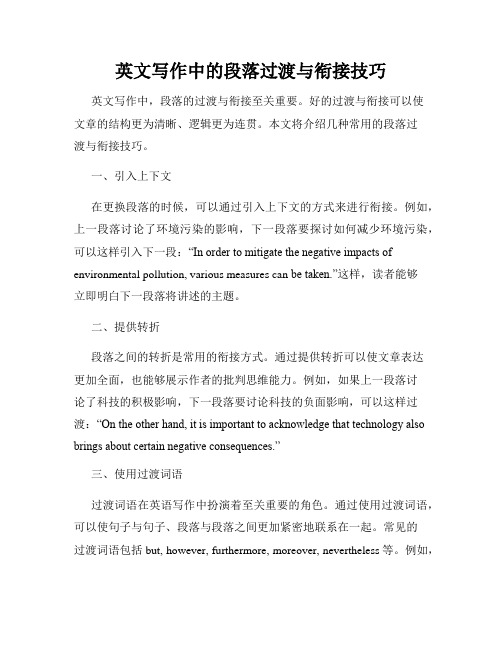
英文写作中的段落过渡与衔接技巧英文写作中,段落的过渡与衔接至关重要。
好的过渡与衔接可以使文章的结构更为清晰、逻辑更为连贯。
本文将介绍几种常用的段落过渡与衔接技巧。
一、引入上下文在更换段落的时候,可以通过引入上下文的方式来进行衔接。
例如,上一段落讨论了环境污染的影响,下一段落要探讨如何减少环境污染,可以这样引入下一段:“In order to mitigate the negative impacts of environmental pollution, various measures can be taken.”这样,读者能够立即明白下一段落将讲述的主题。
二、提供转折段落之间的转折是常用的衔接方式。
通过提供转折可以使文章表达更加全面,也能够展示作者的批判思维能力。
例如,如果上一段落讨论了科技的积极影响,下一段落要讨论科技的负面影响,可以这样过渡:“On the other hand, it is important to acknowledge that technology also brings about certain negative consequences.”三、使用过渡词语过渡词语在英语写作中扮演着至关重要的角色。
通过使用过渡词语,可以使句子与句子、段落与段落之间更加紧密地联系在一起。
常见的过渡词语包括but, however, furthermore, moreover, nevertheless等。
例如,当作者要在两个段落之间进行衔接时,可以使用这样的过渡词语:“In addition, it is worth noting that…”四、运用并列、对比和因果关系并列、对比和因果关系是段落过渡与衔接中常用的手段。
通过运用这些关系,可以使文章的逻辑更加清晰。
例如,在叙述某个观点或事实时,可以使用并列来衔接:“Not only does this contribute to the overall development, but it also creates new opportunities for economic growth.”又如,当两个观点或事实相反时,可以使用对比来衔接:“In contrast, some argue that…”此外,如果一个事实是另一个事实的结果,可以使用因果关系来衔接:“As a result, the number of pa rticipants in the event increased significantly.”五、回顾上文、展望下文回顾上文和展望下文是段落过渡与衔接中常见的技巧。
英语作文分段的方法和技巧

英语作文分段的方法和技巧
在写英语作文时,分段是一个非常重要的技巧,它能让文章结构更清晰,逻辑更明确。
以下是一些常用的英语作文分段方法和技巧:
1. 标题和开头段落:在文章的开头,可以使用一个标题或者引言来吸引读者的注意力。
接着在开头段落中,可以简要介绍文章的主题,并给出背景信息或者观点陈述。
2. 主体段落:主体段落用于展开和阐述文章的主要内容。
一种常见的方法是使用一个段落来讨论一个主要观点或者主题。
在每个主体段落中,可以使用一个主题句来概括该段落的内容,并在接下来的句子中提供详细的解释和支持材料。
3. 过渡段落:过渡段落可以用来连接文章中的不同部分。
这些段落可以用来引导读者到下一个主题或者观点,并确保文章的连贯性。
在过渡段落中,可以使用过渡词语或者句子来引导读者。
4. 重点段落:在文章中,有时候会有一些重要的观点或者信息需要特别强调。
在这种情况下,可以单独将这些内容放在一个段落中,以突出它们的重要性。
5. 结尾段落:在文章的结尾,可以总结文章的主要观点,并给出自己的结论或者建议。
结尾段落也可以用来给读者留下一个深刻的印象,可以使用一个引用、问题或者呼吁来引发读者的思考。
总之,分段是一种组织文章结构和思路的重要技巧。
通过合理使用分段方法和技巧,可以使文章更易读、逻辑更清晰,并提高写作的质量。
英语六级写作段落结构与篇章连贯技巧分析

英语六级写作段落结构与篇章连贯技巧分析在英语六级写作中,良好的段落结构和篇章连贯技巧是取得高分的关键。
本文将分析英语六级写作中常见的段落结构和篇章连贯技巧,并为大家提供一些实用的写作建议。
一、段落结构分析1. 开篇句段落的开篇句是引导读者进入主题的关键句子。
它应该简明扼要地概括本段的主要内容,并引发读者的兴趣。
例如,“To begin with”(首先),“Moreover”(此外),或者“On the other hand”(另一方面),等等。
这些开篇句能够将不同段落之间的逻辑关系连接起来,并为后续句子打下基础。
2. 主题句主题句是段落中最重要的句子,它直接陈述本段的中心思想。
主题句应该简明扼要,能够清晰地传达给读者段落的主旨。
好的主题句能够帮助读者更好地理解文章的结构和主题,因此在撰写过程中,我们应该注重主题句的清晰性和准确性。
3. 发展句发展句是段落中用来支持主题句的句子。
它们提供了更多的论据、细节和例子,以加强段落的说服力。
为了使段落结构更加清晰,我们可以使用一些过渡词或词组,如“Furthermore”(此外),“In addition”(另外),或者“For example”(例如),等等。
这些过渡词能够自然地将句子之间的逻辑关系串联起来。
4. 总结句段落的总结句是对本段主要内容的概括和总结。
总结句不仅可以让读者更好地理解段落的主旨,还可以为下一段的内容过渡。
总结句应该简明扼要,能够给读者一个深刻的印象。
二、篇章连贯技巧分析1. 使用恰当的过渡词语过渡词语在篇章中起到连接段落和句子的作用,使文段更加流畅。
例如,我们可以使用“Firstly”(首先),“Secondly”(其次),或者“Finally”(最后)等词语来引导读者进入下一段或下一部分的内容。
2. 使用恰当的代词和连接词为了使篇章更加连贯,我们可以使用适当的代词和连接词。
代词可以代替前面提到的名词,避免重复使用。
连接词可以连接句子和句子之间的关系,使整个篇章更加流畅。
高分高考英语作文的写作方法与技巧
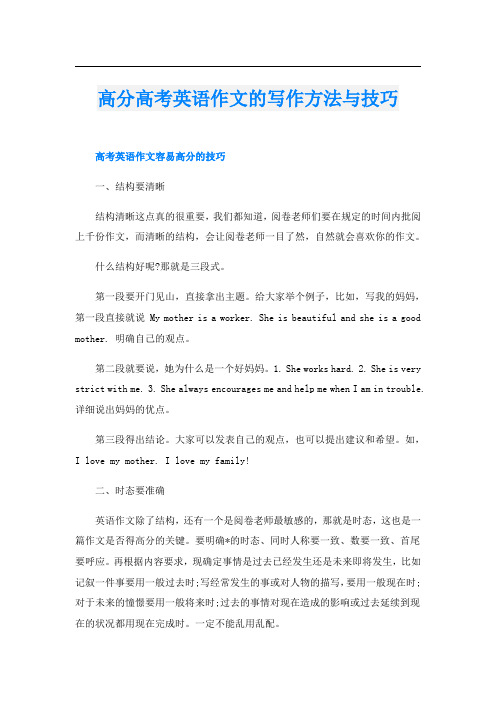
高分高考英语作文的写作方法与技巧高考英语作文容易高分的技巧一、结构要清晰结构清晰这点真的很重要,我们都知道,阅卷老师们要在规定的时间内批阅上千份作文,而清晰的结构,会让阅卷老师一目了然,自然就会喜欢你的作文。
什么结构好呢?那就是三段式。
第一段要开门见山,直接拿出主题。
给大家举个例子,比如,写我的妈妈,第一段直接就说 My mother is a worker. She is beautiful and she is a good mother. 明确自己的观点。
第二段就要说,她为什么是一个好妈妈。
1. She works hard. 2. She is very strict with me. 3. She always encourages me and help me when I am in trouble. 详细说出妈妈的优点。
第三段得出结论。
大家可以发表自己的观点,也可以提出建议和希望。
如,I love my mother. I love my family!二、时态要准确英语作文除了结构,还有一个是阅卷老师最敏感的,那就是时态,这也是一篇作文是否得高分的关键。
要明确*的时态、同时人称要一致、数要一致、首尾要呼应。
再根据内容要求,现确定事情是过去已经发生还是未来即将发生,比如记叙一件事要用一般过去时;写经常发生的事或对人物的描写,要用一般现在时;对于未来的憧憬要用一般将来时;过去的事情对现在造成的影响或过去延续到现在的状况都用现在完成时。
一定不能乱用乱配。
三、短语运用要灵活同学们在写作文的时候,要尽量使用有把握的词,避免不必要的失分。
当然,定语从句、宾语从句等句型,在关键的时候用上一两个,会增添你*的文采。
在英语中存在很多简单又能表达很多意思的短语。
这些短语的运用可以使作文更加原汁原味。
四、写全要点近年的各地高考英语提示性作文比较多,也就是说写作内容几乎都有要点提示,确切地说就是给出写作提纲,这种作文,同学们一定记住不要逐字翻译,但是提示点必须在*中有所体现。
- 1、下载文档前请自行甄别文档内容的完整性,平台不提供额外的编辑、内容补充、找答案等附加服务。
- 2、"仅部分预览"的文档,不可在线预览部分如存在完整性等问题,可反馈申请退款(可完整预览的文档不适用该条件!)。
- 3、如文档侵犯您的权益,请联系客服反馈,我们会尽快为您处理(人工客服工作时间:9:00-18:30)。
Back
Chapter One: The Structure of a Paragraph
1. “启”即开启,开始,引出主题句或引导第一个扩展 句
it is clear that… 显然 lately 最近 recently 最近 there is no doubt that… 毫无疑问 to start with… 首先
also at the same time certainly 又;并且 as a matter of fact 同时 besides 必然地;肯定地 consequently 事实上 另外;此外 结果;因此
especially
for instance furthermore in addition to… in fact in particular indeed
1. 段落的主题 2. 段落的主题句
Back
Chapter One: The Structure of a Paragraph
Ⅰ.段落的主题与主题句
1. 段落的主题 通常一篇文章只有一个中心思想,这个中心 思想可以分为几个主题,每个主题由一个段落来 完成。 段落的组成通常包含三个要素:主题句 (topic sentence)、扩展句 (supporting sentence) 和 结尾句 (concluding sentence)。
Back
Chapter One: The Structure of a Paragraph
3. “转”即转折,用来表示语气的转折
nevertheless
然而;不过 on the contrary otherwise 不同样地 不幸地 unlike
相反地
on the other hand
另一方面
unfortunately
特别是
例如
for example
from now on
例如
从此 此外 事实上 换言之 同样地 同样地
Back
此外;而且 in addition 除……之外 in effect 事实上 in other words 特别是 确实 in the same way likewise
Chapter One: The Structure of a Paragraph
该主题句有三个不同的观点揉在一起,如果作 为一个段落的主题句则不符合要求,该主题句可 分解为三个主题句,由三个段落分别来完成。
Back
Chapter One: The Structure of a Paragraph
请看下面的段落有什么问题:
My name is Roseanna, and I like to keep physically fit. I used to weigh two hundred pounds, but I joined the YMCA (Young men’s Christian Association 基督 教青年会)for an exercise class and diet program. In one year I lost eighty pounds. I feel much better and never want to have that much weight on my five-feet frame(身躯) again. I bought two new suitcases last week. Every day I practice jogging three miles, swimming fifteen laps, lifting twenty-pound weights and playing tennis for one hour. My mother was a premature baby (早产儿).
在一个段落中,即使所有的句子意思都清楚,并且逻辑 顺序排列正确,但是如果缺乏句与句之间的恰当的过渡,整 个段落的连贯性仍会受到影响。一般使用合适的过渡词语来 加强句与句之间的衔接或连贯。一个段落通常由“启”、 “承”、“转”、“合”这样的一些环节构成,也就是说要 正确使用启、承、转、合的词或词组,这样的段落才会既有 统一性、完整性,又有连贯性。下面是一些常用的“启、承、 转、合”过渡词语:
Chapter One: The Structure of a Paragraph
II. 段落的扩展
其次,一个段落必须有若干扩展句, 使主题思想得到充分展开,从而给读者一个 完 整 的 感 觉 , 这 就 是 段 落 的 完 整 性 (The
Integrity of a Paragraph) 。扩展句和主题
Back
Chapter One: The Structure of a Paragraph
at first 首先
1. “启”即开启,开始,引出主题句或引导第一个扩展 句
currently 最近;现在
firstly 首先 generally 一般说来
in the beginning 首先
at present 当今 first 首先;第一 first of all 首先 generally speaking 一般说来 in the first place 首先
不同于
regardless of 不管;不顾 whereas
yet
the differences are as follows 区别如下 然而 while 然而;另一方面 然而;但是
Back
Chapter One: The Structure of a Paragraph
4. “合”即合拢,总结,表示段落的结束
Back
Chapter One: The Structure of a Paragraph
例如: 主题句:Beijing is famous for its temperate
climate, its large population, and its rapid industrial development.
moreover 此外;而且 no doubt 无疑
namely 也就是说 second 第二
siቤተ መጻሕፍቲ ባይዱilarly 同样地
soon 不久
more than that 再者;更重要的是 or 即;也就是说 即; particularly 特别是 secondly 第二 so 所以 such as 例如
Back
it is self-evident that… 不言而喻 presently 此刻;现在 there is some evidence that… 现有证据表明 to begin with… 首先
Back
Chapter One: The Structure of a Paragraph
2. “承”即承接,用来承接主题句或第一个扩展句
accordingly 于是
to sum up 总之
as a consequence 因此
Chapter One: The Structure of a Paragraph
take…for example 以 ……为例 that is to say,… 即;也就是说 third 第三 the most important 再者;更重要的是 what’s more 再者;更重要的是 that is,… 即; 也就是说 there are many reasons why… ……的原因有许多 thirdly 第三 truly 事实上;其实是 what’s more important 再者;更重要的是
Back
Chapter One: The Structure of a Paragraph
2. 段落的主题句
主题句是一个段落中最具概括性的句子。一般包含两个 基本内容:1)本段要讨论的中心人物或事物——即主题词; 2)作者对这个中心人物或事物的态度、观点或见解——即扩 展范围或关键词。 主题句既不能过于概括,也不能过于具体。主题句过于 概括(即过于笼统或题目太大),很难用几句话说清楚,通常 会因为得不到应有的充实而显得空泛无力,从而造成不能有效 地表达主题思想。主题句过于具体(即缺乏概括性的观点), 则无法展开段落,作者的思想就没有发挥的余地,容易造成对 一个意思的重复描述。
Back
Chapter One: The Structure of a Paragraph
本段的主题句是“I like to keep
physically fit”,段中所有的句子应围 绕这一主题。但段中有两个irrelevant sentences,一个是I bought two new suitcases last week,另一个是 My mother was a premature baby.
过于具体。
主题句可放在句首、句中和句尾。主题句放在句首是 一种好的写作方法,可以时刻提醒作者不要跑题,而且便 于读者阅读理解。主题句放在句中,对段落的组织较困难, 一般用在记叙和描述文体中。主题句放在句尾通常是段落 的开始列举事例或事实,最后总结归纳,引出段落的主题 思想。有时作者为强调起见,在段落的开头点明了主题, 结尾又会重复主题,不过不是简单的重复,而是在意思上 与开头相呼应,或者对段落内容进行总结。 Back
Part Two: Paragraph Writing
Chapter One: The Structure of a Paragraph
1. 段落的主题与主题句 2. 段落的扩展 3. 段落的结尾
Chapter Two: Basic Paragraph Patterns
1. 列举法(Listing) 2. 举例法(Exemplification) 3. 时空顺序法(Time and Space Sequence) 4. 因果分析法(Cause and Effect) 5. 比较对照法(Comparison & Contrast) 6. 分类法(Classification)
